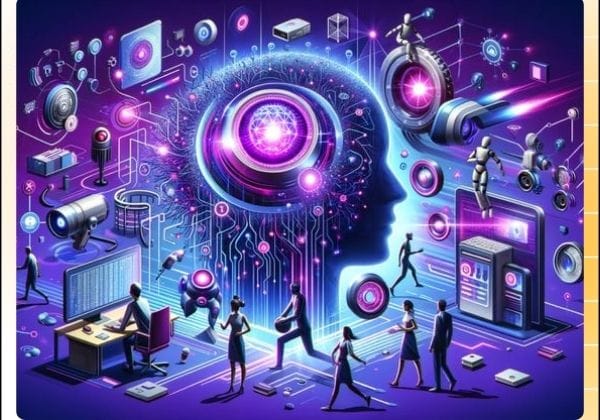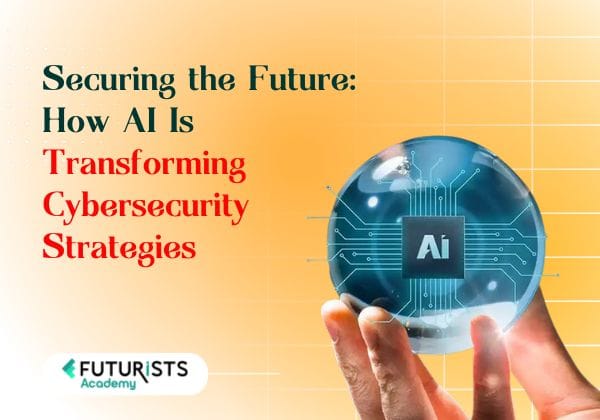In 2025, AI is transforming cybersecurity strategies as the digital threat landscape becomes more volatile than ever. With remote work, cloud adoption, and IoT expanding attack surfaces, organizations are facing increasingly sophisticated cyber threats. Traditional security tools, while still relevant, are no longer sufficient to counter today’s complex, fast-evolving attacks. Artificial Intelligence (AI) is rapidly becoming a cornerstone of modern cybersecurity strategies.
A staggering 87% of global organizations have reported being targeted by AI-powered cyber attacks, highlighting the urgency of integrating AI into defense systems. In response, the AI-based cybersecurity market is projected to skyrocket to $96.81 billion by 2032, driven by demand for advanced detection and response solutions.
AI is reshaping the cybersecurity paradigm through enhanced threat detection, real-time automated incident response, and predictive capabilities that identify risks before they materialize. This blog explores how AI is not just a technological upgrade—but a transformational force in cybersecurity.
From Rule-Based Defenses to Intelligent Systems: How AI Is Transforming Cybersecurity Strategies
Cybersecurity has come a long way since the 1980s, when rule-based systems formed the foundation of digital defense. These static systems, while effective against known threats, failed to adapt to the dynamic tactics of modern cybercriminals. The integration of neural networks and machine learning in the 2010s marked a turning point, enabling systems to learn from data patterns and detect anomalies proactively.
The rise of generative AI has further revolutionized both offensive and defensive cybersecurity. It allows defenders to simulate sophisticated threats, but also empowers attackers to craft smarter, more targeted attacks.

As of 2022, the global AI cybersecurity market stood at $15.25 billion, signaling widespread adoption across industries. However, AI’s dual-use nature—serving both threat actors and defenders—makes it a double-edged sword.
nstitutions like Futurists Academy in Guwahati are pioneering efforts to prepare cybersecurity professionals for this AI-integrated future, ensuring they’re equipped to thrive in a landscape where AI is transforming cybersecurity strategies and driving robust digital protection.
Breakthrough Technologies: How AI Elevates Threat Detection
AI technologies have significantly elevated the way organizations detect and neutralize threats. Machine learning (ML) algorithms are at the forefront, identifying irregular patterns and flagging anomalies that may signal cyberattacks. These systems improve over time, learning from new data and continuously enhancing accuracy.
Natural Language Processing (NLP) helps security tools analyze textual data—emails, logs, and dark web chatter—to identify potential threats. AI-powered continuous monitoring systems now offer 24/7 surveillance across networks, ensuring real-time threat visibility.

Advanced behavioral analysis capabilities detect deviations in user or system behavior, flagging possible insider threats or compromised accounts. Tools like Darktrace’s Enterprise Immune System use AI to mirror the human immune response, autonomously identifying and responding to novel threats.
AI implementations have shown to improve threat detection rates by over 95%, significantly reducing the time to identify and respond to breaches—transforming cybersecurity from reactive to proactive.
Smarter Defense: Automated Incident Response in Real-Time
Speed is critical in cybersecurity. AI is transforming cybersecurity strategies by enabling real-time responses to detected threats, dramatically reducing reaction time and potential damage. AI-driven systems can contain breaches, isolate affected systems, and even initiate remediation protocols without human intervention.
This automation not only lightens the workload of security teams but also improves consistency and speed in crisis scenarios. Case studies show how financial institutions have deployed AI to thwart ransomware attacks within seconds of detection—demonstrating how AI is transforming cybersecurity strategies from reactive defense to proactive protection.
Emerging quantum AI technologies are pushing the envelope further, offering high-speed processing to outpace increasingly sophisticated cyber threats. These advancements promise to redefine real-time defense capabilities in the years ahead.
Proactive Protection: AI-Powered Threat Hunting and Forensics
Modern cybersecurity is moving from passive defense to proactive threat hunting—a shift powered by AI. Instead of waiting for alerts, AI tools actively scan systems for indicators of compromise or unusual behavior. AI is transforming cybersecurity strategies by enabling faster, more intelligent threat identification and response.
AI dramatically speeds up digital forensics, enabling quick reconstruction of attack timelines and identification of breach vectors. By analyzing massive log datasets and user activity records, AI can pinpoint threats that would take human analysts days to detect.
Simulation of potential attacks and penetration testing using AI also strengthens cyber resilience, exposing hidden vulnerabilities before hackers can exploit them.
The Double-Edged Sword: AI-Driven Cyber Threats in 2025
While AI bolsters cybersecurity, it also supercharges cybercriminal capabilities. AI-generated phishing emails have a click-through rate of 54%, compared to just 12% for those written by humans, due to their personalized and grammatically flawless content.
Hackers now use AI to build adaptive malware and ransomware, making traditional signature-based defenses obsolete. AI can scan for vulnerabilities automatically, launch attacks autonomously, and evolve in real time.
Deepfakes and synthetic identity attacks are eroding trust in digital communications, while data poisoning corrupts AI models by feeding them malicious input.
Perhaps most concerning, AI lowers the skill threshold for cybercrime, allowing even novices to generate malicious code using publicly available AI tools—creating a surge in low-level but widespread attacks.
What’s Next: AI Cybersecurity Trends Shaping the Future
Looking ahead, quantum AI is poised to revolutionize cryptography, enabling unbreakable encryption while also threatening current security protocols. Predictive AI models will anticipate attacks based on behavioral and environmental factors, reducing zero-day exploits.
As AI begins detecting zero-day vulnerabilities before they’re weaponized, the arms race between attacker and defender AI will intensify. Governments are also stepping in with regulatory frameworks to govern ethical AI use in cybersecurity.

Educational institutions like Futurists Academy are expanding their curricula to include these emerging trends, ensuring that future professionals are not only technologically equipped but also ethically grounded.
Bringing AI into Your Security Framework: Implementation Insights
Organizations looking to adopt AI in cybersecurity must follow best practices—including data privacy compliance, robust integration strategies, and regular model training. A major challenge lies in integrating AI tools with existing infrastructure, which requires skilled professionals.
Though upfront costs can be high, cost-benefit analyses show substantial ROI due to reduced breach incidents and faster response times. Security teams must develop proficiency in managing AI systems, understanding algorithm limitations, and interpreting AI-generated insights.
Futurists Academy in Guwahati ensures that even its digital marketing training integrates cybersecurity awareness, emphasizing the importance of protecting digital assets in every discipline.
Take the Next Step in Cybersecurity Education
Explore the future of AI in cybersecurity with Futurists Academy, Guwahati’s leading institute for digital and tech training.
Contact us today to enroll in programs designed for tomorrow’s security professionals.
Conclusion: Staying Ahead in the AI Cybersecurity Race
Artificial Intelligence is no longer a futuristic concept in cybersecurity—it’s the present and future of digital defense. From accelerating threat detection to automating real-time response and enabling proactive threat hunting, AI is transforming how organizations protect their assets.
As cyber threats grow in sophistication, staying ahead of the curve with AI-driven security solutions is crucial. Institutions like Futurists Academy are preparing the next generation of professionals to lead this charge.
The path forward is clear: embracing AI is not just strategic—it’s essential for cyber resilience in a rapidly evolving digital world.

